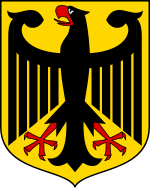Deutsche Bundesbank
| Deutsche Bundesbank | |||
|
|||
| Headquarters | Frankfurt am Main | ||
|---|---|---|---|
| Established | 1957 | ||
| President | Axel A. Weber | ||
| Central Bank of | Germany | ||
| Website | www.bundesbank.de | ||
| Preceded by | Bank deutscher Länder | ||
| Succeeded by | European Central Bank (1999)1 | ||
| The Deutsche Bundesbank still exists but many functions have been taken over by the ECB. | |||
The Deutsche Bundesbank (German for German Federal Bank) is the central bank of the Federal Republic of Germany and as such part of the European System of Central Banks (ESCB). Due to its strength and former size, the Bundesbank is the most influential member of the ESCB. Both the Deutsche Bundesbank and the European Central Bank (ECB) are located in Frankfurt am Main. It is sometimes referred to as "Buba" for Bundesbank[1].
The Bundesbank was established in 1957 and succeeded the Bank deutscher Länder, which introduced the Deutsche Mark on 20 June 1948. Until the Euro was physically introduced in 2002, the Deutsche Bundesbank was the central bank of the former Deutsche Mark ("German Mark", sometimes known in English as the "Deutschmark").
The Deutsche Bundesbank was the first central bank to be given full independence, leading this form of central bank to be referred to as the Bundesbank model, as opposed, for instance, to the New Zealand model, which has a goal (i.e. inflation target) set by the government.
The Bundesbank was greatly respected for its control of inflation through the second half of the 20th century. This made the German Mark one of the most respected currencies, and the Bundesbank gained substantial indirect influence in many European countries.
| Germany |
 This article is part of the series: |
|
|
|
Constitution
Parliament
Judiciary
Executive
Divisions
Elections
Foreign policy
|
|
Other countries · Atlas |
History of the Bundesbank as an organization
For history of German central banks see also: Reichsbank
1948-1957
The history of the Bundesbank is inextricably linked with the history of the German currency after the Second World War. Following the total destruction after the war, the old Reichsmark was practically worthless, and a currency reform was implemented in the western occupation zones including West Berlin: on 21 June 1948, the D-Mark, or Deutsche Mark, replaced the Reichsmark. The currency reform was based on laws enacted by the Allied military government. In preparation, the Western Powers established a new two-tier central bank system in the occupied zones; in its federal structure, it was modeled on the Federal Reserve System of the USA. It comprised the central banks of the states (Länder) of the West German occupation zones and the Bank deutscher Länder in Frankfurt am Main, which was created on 1 March 1948. The central banks of the Länder acted as central banks within their areas of jurisdiction. The Bank deutscher Länder, whose share capital was held by the central banks of the Länder, was responsible for issuing bank notes, co-ordinating policy and various central tasks including management of foreign exchange. The supreme governing body of the two-tier central bank system was the Central Bank Council (Zentralbankrat) set up at the Bank deutscher Länder. It consisted of a president, the presidents of the central banks of the Länder and the president of the directorate (board) of the Bank deutscher Länder. Amongst other things, the Central Bank Council determined policy on bank rate and minimum reserve policy, open-market policy guidelines and granting of credit. After the negative experience with a central bank subject to government orders, the principle of an independent central bank was established. The Bank deutscher Länder was independent of German political bodies from the start, including the federal German government, which was active from September 1949. It achieved independence from the Allies in 1951.
1957-1990
The German "Basic Law" (constitution), which had come into force on 1949-05-23, placed an obligation on the German federal legislature to establish a federal bank responsible for the issue of bank notes and currency.[2]. The legislature fulfilled this obligation by passing the Bundesbank Act (BBankG) of 1957-07-26, which abolished the two-tier structure of the central bank system. [3] The central banks of the Länder were now no longer independent note-issuing banks, but became regional headquarters of the Bundesbank, nevertheless retaining the title "state central bank" (Landeszentralbank).
The Central Bank Council remained the supreme decision-making body of the Bundesbank. It was now made up of the presidents of the central banks of the Länder and a board of directors based in Frankfurt am Main. The Central Bank Council decided on the currency and credit policy and laid down rules for management. As the central executive body of the Bundesbank, the Directorate (Direktorium) was responsible for implementing the decisions of the Central Bank Council. The Directorate ran the bank and was, in particular, responsible for dealings with the federal government and its "special assets" (Sondervermögen), for transactions with credit institutes operating in the Federal republic of Germany, for currency transactions, and foreign commercial transactions, and for open-market dealings. The Directorate was made up of the president and the vice-president of the Bundesbank and up to 6 additional members.
The central banks of the Länder carried out business falling in their areas independently. The Bundesbank Act explicitly made them responsible for dealings with public bodies and credit institutes. The central Banks of the Länder also controlled the subsidiary bodies (Zweiganstalten), now called branches (Filialen). Overall management of each Land central bank was in the hands of its executive board (Vorstand), which as a rule consisted of the president and the vice-president of the bank.
1990-1993
Following the "Fall of the Berlin Wall", the treaty of 1990-05-18 created an economic, social and currency Union between the Federal Republic of Germany and the German Democratic Republic; it came into force on 1990-07-01 and made the D-Mark the sole legal tender in both German states. The Bundesbank was made responsible for money and currency policy within the whole of the currency union. A "Provisional Administration Body" was set up for the purpose of implementing the treaty, and this body continued to operate beyond the official date of reunification until 1992-10-31. The Bundesbank Act was amended to adjust the organizational structure of the Bundesbank to better match changed circumstances following German reunification, and at the same time streamline the organisation. The eleven central banks of the Länder and the Provisional Administrative Body were replaced by 9 central banks of similar economic size.
1993-2001
The Maastricht Treaty that came into force on 1993-11-01 laid the foundation for the European Economic and Currency Union (EECU). National responsibility for monetary policy was transferred, at the Community level, to the European System of Central Banks (ESCB), comprising the European Central bank (ECB) and the national central banks (NCBs) of the EU states. Until the ECB became fully responsible for currency in 2001, the Bundesbank had three governing bodies. The Central Bank Council (Zentralbankrat) was the supreme body of the Bundesbank. It was made up of:
- the Directorate, which comprised the president, the vice-president and six additional members. These eight people were nominated by the Federal Government (Bundesregierung)
- The nine presidents of the Landeszentralbanken. These were nominated by the Bundesrat.
The Directorate was the executive body of the Bundesbank, while all currency policy decisions were made by the Central Bank Council.
2001-present (2006)
In 2001 the ECB took over full control of currency. The Bundesbank Act was last amended in 2002 by the 7th Law Amending the Law on the Bundesbank of 2002-04-30, which gave the Bundesbank its current structure.
The Bundesbank today

After the ECB took over responsibility for currency, the Bundesbank continued to exist. Its duties were redefined by the 7th Law amending the "Law on the German Bundesbank" of 2002-04-30.
Duties
The duties of the Bundesbank are defined in Section 3 of the Bundesbank Act: [3]
- The Deutsche Bundesbank, being the central bank of the Federal Republic of Germany, is an integral part of the European System of Central Banks (ESCB). It shall participate in the performance of the ESCB's tasks with the primary objective of maintaining price stability, and shall arrange for the execution of domestic and international payments. In addition, it shall discharge the duties assigned to it under this Act or other legislation
Unlike other central banks such as the Bank of England and the U.S. Federal Reserve (but like the ECB), the Bundesbank is not officially responsible for maintaining the stability of the financial system and is not a lender of last resort. [4] Based on the Bundesbank Act and the ECB Statute, the Bundesbank has four areas of activity, which it mostly handles jointly with the ECB:
- the Bundesbank as a note-issuing bank
- the Bundesbank as the banks' banker (clearing house and bank supervision)
- the Bundesbank as the state's banker
- the Bundesbank as the manager of currency reserves
The Bundesbank as a note-issuing bank
As a note-issuing bank, the Bundesbank provides the economy with cash, and ensures the physical circulation of cash. It checks the cash delivered by banks and money transport companies, removes counterfeit money from circulation and hands it to the police. It changes D-Mark holdings still in circulation, without any time limit and replaces damaged or mutilated notes (National Analysis Centre for Counterfeit and Damaged Banknotes and Coins). It also issues information on the safety mechanisms for notes and coins and issues a weekly bulletin on the volume of cash in circulation.
The Bundesbank as the banks' banker
In relation to the commercial banking system, the Bundesbank has two functions:
Clearing house for commercial banks
Firstly, the Bundesbank is a refinancing source and clearing house for the commercial banks. The commercial banks can use what are known as "refinancing instruments" to cover their needs for central bank money through the Bundesbank and the ECB. Until the end of 1998, the control of the money supply by this method was one of the main tasks of the Bundesbank. Since 1999-01-01, one of the principal aims of the ECB has been to maintain price stability by means of its monetary strategy. Commercial banks can deposit money that is temporarily surplus to requirements with the Bundesbank/ECB (known as a deposit facility). The Bundesbank supports cross-border payments between domestic and foreign commercial banks, for instance by means of the German real time gross transfer system RTGSplus, TARGET, and in future TARGET2.
Bank supervision
The bank also helps to regulate commercial banks, in close cooperation with the Bundesanstalt für Finanzdienstleistungsaufsicht (BAFIN). [5]
The Bundesbank as the state's banker
As the state's banker, the Bundesbank provides accounts and performs normal banking services for federal, state (Land) and local authorities, as well as for the statutory social security organizations. All such accounts are required to have a positive balance, i.e. the Bundesbank is not allowed to grant credits to the public sector. This is due to negative historical precedents in connection with the financing of two world wars by the Deutsche Reichsbank. It also carries out securities transactions for the federal government (Bundesfinanzagentur).
The Bundesbank as the keeper of the currency reserves
Currency reserves are all assets of the Bundesbank that are not specified in EUR, including gold reserves, securities in foreign currency, credit with foreign banks, foreign exchange, etc. Currency reserves can be invested for profit and also provide a possibility of intervening in the market if the exchange rate fluctuates strongly. The gold reserves of the Bundesbank are the second largest in the world (after the U.S Federal Reserve) At present (November 2006), the Bundesbank has gold reserves of 3,427 tonnes, with a market value about €50.6 billion. (2006-02-17).
Structure
The Bundesbank has 9 regional headquarters in the Länder, the former central banks of the Länder and 66 branches (Filiale). As of 2006-06-30, the Bundesbank had a total of 12,474 employees. [6]. By the end of 2007 the number of regional subsidiaries is to be reduced to 47. The regional subsidiaries are available to banks, public authorities and money transport enterprises for the provision of cash and the clearing of credit transfer.
Governance
The executive board (Vorstand) is the supreme governing body of the Bundesbank. It comprises:
- the president, the vice president and two additional board members. These four people are put forward by the German government.
- Four additional members of the executive board; these are put forward by the Bundesrat.
All members of the executive board are appointed by the Federal President, normally for eight years, but at least for five years.
Presidents of the German central bank
Presidents of the predecessors of the German Bundesbank
- 1948–1957: Dr. h. c. Karl Bernard, Chairman of the Central Bank Council (Zentralbankrat) of the Bank deutscher Länder
- 1948–1957: Dr. h. c. Wilhelm Vocke, President of the Directorate of the Bank deutscher Länder, from 1957-08-01
Presidents of the German Bundesbank
- 1958–1969: Dr. Karl Blessing
- 1969–1977: Dr. Karl Klasen
- 1977–1979: Dr. Otmar Emminger
- 1980–1991: Dr. h. c. mult. Karl Otto Pöhl
- 1991–1993: Helmut Schlesinger
- 1993–1999: Dr. Dr. Hans Tietmeyer
- 1999–2004: Ernst Welteke
- 2004: Dr. Jürgen Stark, interim president
- since 2004: Professor Axel A. Weber
Current Executive Board of the Deutsche Bundesbank
The Bundesbank's decision-making body is the Executive Board. According to current regulations, it comprises the President, the Vice-President and six other members. As of 2006-11-30 its membership is as follows:
- Professor Axel A Weber
- President of the Deutsche Bundesbank
- Chairman of the Executive Board
- Professor Franz-Christoph Zeitler
- Vice-President of the Deutsche Bundesbank
- Dr Hans Georg Fabritius
- Professor Hermann Remsperger
- Dr Edgar Meister
- Professor Hans-Helmut Kotz
- Dr Hans Reckers
Personnel reductions
The Bundesbank currently (2006-09-30) employs a total of 12,432. The number is expected to fall to 11,300 by the end of 2007 (with a reduction in the number of branches to 47) and 10,300 by the end of 2010.
Disputes between the Bundesbank and the government
The statutory independence of the central bank guaranteed by the Bundesbank Act does not ensure that there will be no disputes between the central bank and government.
Dispute over currency union with East Germany
One particularly public dispute was in the lead-up to German re-unification. When a customs union was created between the former East Germany (German Democratic Republic) and West Germany (the "old" Federal Republic of Germany), there was a dispute over the rate of exchange for conversion of East German money to Deutschmarks. The Chancellor (Helmut Kohl) decided to ignore the advice of the Bundesbank, and chose an exchange rate of 1:1. The Bundesbank feared that this would be excessively inflationary as well as very significantly impairing the economic prospects of the area of the former East Germany. This dispute was particularly public because of the Bundesbank policy of communicating openly on such matters. Although public opinion normally supported the Bundesbank in matters of combating inflation, in this case Helmut Kohl prevailed, and the President of the Bundesbank, Pöhl, resigned. The Bundesbank had to use monetary measures to offset the inflationary effect. [4]
The Bundesbank in the news
In 2004 the president of the Bundesbank, Ernst Welteke, resigned after the press published allegations that his hotel bills for a New Year celebration had been paid by a commercial bank and he was criticized for his handling of the affair. There were also some allegations that this was part of a political intrigue to remove Welteke from office because he opposed selling Bundesbank gold reserves, as desired by the government. After Pöhl (see above), Welteke was the second Bundesbank president to resign.[7] [8]
Miscellaneous
The Bundesbank runs a large economic research centre in Frankfurt and 9 regional departments within Germany. The Bundesbank has a large specialist library, which is also open to the public, and a money museum.
They also destroy and/or sell discontinued coins to wholesale dealers, gathered from across Germany in approximately 21 pound bags.
Publications of the Bundesbank
The Bundesbank produces a number of regular publications and statistics (see Web site)
See also
- Economy of Germany
- Euro
- German mark
- Money Museum
References
- ↑ commentary14
- ↑ Article 88 of the Grundgesetz", translation of the version as amended to take account of the European Union
- ↑ 3.0 3.1 Bundesbank Act (English)
- ↑ 4.0 4.1 Alessandro Prati and Garry J. Schinasi: Ensuring Financial Stability in the Euro Area, in IMF quarterly publication Finance & Development, December 1998, Volume 35, Number 4 [1]
- ↑ Memorandum of Understanding relating to Cooperation between the Bundesanstalt für Finanzdienstleistungsaufsicht and the Deutsche Bundesbank regarding the supervision of credit and financial services institutions
- ↑ Personnel statistics http://www.bundesbank.de/personal/personal_statistik.en.php?print=no& (English);
More details here: http://www.bundesbank.de/personal/personal_statistik.php (German) - ↑ "Welteke eckt mit "der Welt" an". Rhetorik.ch. Knill+Knill Kommunikationsberatung (2004-04-09). Retrieved on 2006-12-09.
- ↑ "2004 – Das war’s" (in German), DIE ZEIT online, DIE ZEIT (2004-12-31). Retrieved on 2006-12-09.
This article incorporates text translated from the corresponding German Wikipedia article as of 2006-11-25.
Further reading
- edited by the Deutsche Bundesbank, ed.. Fifty years of the Deutsche Mark: Central Bank and the currency in Germany since 1948 / with contributions by Ernst Baltensperger ... [et al.]; with a preface by Hans Tietmeyer ; and a foreword by Otmar Issing(Fünfzig Jahre Deutsche Mark. English.). Oxford: Oxford University Press. ISBN 0-19-829254-6.
- Marsh,, David. The Bundesbank: The Bank That Rules Europe. London: Heinemann. ISBN 0-434-45116-9.
- edited by Stephen F. Frowen and Robert Pringle, ed.. Inside the Bundesbank. foreword by Hans Tietmeyer. Basingstoke: Macmillan in association with Central Banking. ISBN 0-333-69988-2 ISBN 0-312-21253-4 (St. Martin's Press).
- Die Deutsche Bundesbank. Aufgabenfelder, Rechtlicher Rahmen, Geschichte, Selbstverlag der Deutschen Bundesbank: Frankfurt am Main, April 2006, ISBN 3-86558-151-X (PDF) (German)
External links
- (German) (English) Official site of Deutsche Bundesbank
|
||||||||||||||||||||||||||||||||||||||||||||||||||
|
||||||||||||||
